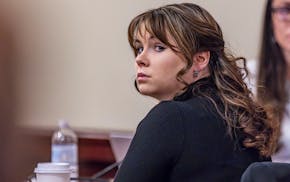Joan Baez and Joni Mitchell sing. Patti Smith and Allen Ginsberg recite poetry. And Bob Dylan talks, rocks and even drives the tour bus.
It's all in a new Netflix documentary, one of those talk-heavy music movies that Dylan fans always hope will offer insights into the self-consciously mysterious music icon.
In "Rolling Thunder Revue: A Bob Dylan Story by Martin Scorsese," legendary beat poet Ginsberg waxes philosophical about Rolling Thunder — Dylan's rambling, vaudeville-like 1975-76 tour featuring Roger McGuinn, Ramblin' Jack Elliott, Baez, Mitchell, Ginsberg and others in unconventional venues like the Mahjong Parlor in Falmouth, Mass.
The slippery Minnesotan's most freewheeling tour, Rolling Thunder was about building a community, and what a community can do, Ginsberg observes in the film.
Forty-some years later, Dylan reflects on what Rolling Thunder was about. Or not. "I don't have a clue," he says on camera, a hint of wariness in his eyes. "Because it's about nothing."
That might make you think of Jerry Seinfeld, or maybe Mr. Jones in Dylan's own song "Ballad of a Thin Man." You know: "Something is happening here but you don't know what it is."
Maybe it's not necessary to explain the money-losing, consciousness-raising Rolling Thunder Revue. It's enough to simply appreciate the powerful and historic performances in this often compelling, predictably elusive 142-minute film.
There's a scary seething in his eyes and a furious conviction in his voice as Dylan sings the newly penned protest saga "Hurricane," about wrongly imprisoned prize fighter Rubin (Hurricane) Carter. During "Isis," another unreleased-at-the-time selection, he spits out the words, his eyes spooky and feverish, his body jittery like Jagger's.
Opines Baez years later: "The charisma that he has, I've never seen anywhere before or since."
Perhaps the prize gem in "Rolling Thunder" is Mitchell, with just her acoustic guitar, performing her brand-new song "Coyote" in Gordon Lightfoot's Toronto home, with Dylan and McGuinn trying to follow along on their guitars. She implies she wrote the song about the tour. A listener might picture Dylan as Coyote, the guy who "just picked up a hitcher, a prisoner of the white lines on the freeway."
Also priceless is footage of Baez doing a wigged-out hippie dance to McGuinn's "Eight Miles High" as if she were in the crowd and not on stage.
There's also a precious scene of Baez dressed up like Dylan. Mimicking the whiteface stage makeup he wore on Rolling Thunder and sporting a broad-brimmed hat festooned with flowers, she even fooled some of the musicians on the tour.
"Rolling Thunder" features wonderful glimpses of Carter out of prison and being celebrated in concert. Years later, he was interviewed for this doc, reflecting on his life, imprisonment and Dylan.
Carter is one of several talking heads captured before they recently passed; others include rockabilly singer Ronnie Hawkins and playwright/actor Sam Shepard, whom Dylan enlisted to pen a screenplay about Rolling Thunder. He's credited as co-writer of Dylan's own film about the tour, 1978's sprawling, not-very-approachable "Renaldo and Clara," which was part documentary, part interviews and part fictional dramatic vignettes.
While Scorsese's "Rolling Thunder" is much more accessible, it similarly blends truth and fiction. Unlike the filmmaker's definitive 2005 Dylan doc "No Direction Home," this movie raises more questions than it answers.
Did Dylan really get the inspiration to wear whiteface from Japan's Kabuki theater or from Rolling Thunder violinist Scarlet Rivera's boyfriend in Kiss? (Gene Simmons has confirmed that he and Rivera were dating then.)
Did a teenage Sharon Stone really attend the Rolling Thunder tour (wearing a Kiss T-shirt) with her mom?
Why did Scorsese interview Jack Tanner — a fictional presidential candidate played by actor Michael Murphy in a 1988 Robert Altman/Garry Trudeau mockumentary — about politics in 1976?
In this documentary, there is no consistent attempt to frame the Rolling Thunder story with a narrator providing context. Instead, Scorsese pieces together a collage of interviews from then and (mostly) now, powerful concert performances and curious offstage footage (Dylan driving the tour's RV; Dylan and Ginsberg visiting Jack Kerouac's grave).
What does it all mean? Dylan's marriage was breaking up as he made a high-profile comeback in 1974, touring arenas with the Band following an eight-year absence from the road, and recording his landmark album "Blood on the Tracks." He needed an escape. So, he put together a kitchen-sink tour of singers, players, poets and actors, and then hid behind a mask onstage so, as he put it, he could tell the truth.
"Life isn't about finding yourself or finding anything," he declares in the movie. "Life is about creating yourself."
In the end, "Rolling Thunder" feels more like a document than a documentary — an essential document for any Dylan fan.
Twitter: @JonBream • 612-673-1719
Characters enter the public domain. Winnie the Pooh becomes a killer. Where is remix culture going?
Salman Rushdie's 'Knife' is unflinching about his brutal stabbing and uncanny in its vital spirit
WNBA fashionistas showcase their styles at the draft with spotlight on women's hoops
Paris Hilton backs California bill to bring more transparency to youth treatment facilities
